Student Union
- By VOA News
Can campus protests get international students deported?

Inside Higher Ed takes a look at the issue of international students protesting on U.S. campuses. Specifically, can it lead to students being deported?
Read the full article here. (September 2024)
- By VOA News
Want to work in the US as an international student? Know the rules
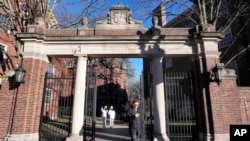
The Economic Times of India outlines the rules for working in the U.S. as an international student. "[N]avigating the complex regulations and visa restrictions is crucial for securing a work opportunity in the US as a student," the story says.
Read the full article here. (August 2024)
- By VOA News
Columbia U. news site offers tips for international students
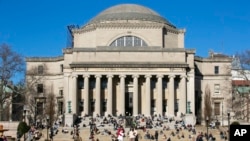
Bwog, a student-run campus news site at Columbia University, has a guide for international students spending their first semester in the U.S.
Among the tips:
Expect some culture shock
Don't be afraid to ask for help
Stay in touch with people from home.
Read the full article here. (August 2024)
NCAA's $2.78 billion settlement with colleges to allow athlete payments gets preliminary approval

A judge granted preliminary approval Monday to the $2.78 billion legal settlement that would transform college sports by allowing schools to pay players.
U.S. District Judge Claudia Wilken released an order setting a timeline for a deal that would put millions of dollars into the pockets of college athletes, who can begin applying for payment on October 18.
A final hearing is set for April 7, 2025, the day of college basketball's national title game. If finalized, the deal would allow the biggest schools to establish a pool of about $21.5 million in the first year to distribute to athletes via a revenue-sharing plan. Athletes would still be able to cut name, image and likeness deals with outside groups.
"We are pleased that we are one step closer to a revolutionary change in college athletics that will allow billions in revenue sharing," said plaintiff attorney Steve Berman.
The judge's approval comes 11 days after attorneys tweaked wording in the original settlement agreement to address Wilken's concerns. The main change involved getting rid of the word "boosters" and replacing it with a better-defined description of whose potential NIL deals would be subject to oversight by a neutral arbitrator once the deal goes through.
That did not, however, strike to the heart of the settlement, which sets up a revenue-sharing arrangement between schools and the athletes. The $21.5 million figure comes from the 22% of average revenue that power conference schools generate through media rights, tickets and other sources. It will be recalculated periodically through the 10-year window that the agreement covers.
"We are thrilled by Judge Wilken's decision to give preliminary approval to the landmark settlement that will help bring stability and sustainability to college athletics while delivering increased benefits to student-athletes for years to come," NCAA President Charlie Baker said. "Today's progress is a significant step in writing the next chapter for the future of college sports."
This settlement also allows former players to apply for payments to make up for lost revenue they would have received through NIL deals that weren't allowed in college sports before 2021. It sets up a framework to regulate future NIL deals and replaces scholarship caps with "roster limits," which will grow to 105 for football, the biggest sport at most major universities.
This settlement resolves three major antitrust lawsuits filed against the NCAA, including one spearheaded by Grant House, a former swimmer at Arizona State University. Berman's law firm says the value of new payments and benefits to college athletes is expected to exceed $20 billion over 10 years.
Still unknown, however, is how long the terms of this deal will last. Litigation regarding the rights of players to unionize and potentially be considered employees remains unsettled. Meanwhile, the NCAA is pushing for federal legislation to knit together a streamlined policy for NIL, which is currently regulated by a patchwork of state laws, legal settlements and NCAA rules.
Grace period for US student loan payments is over. Here's what you need to know
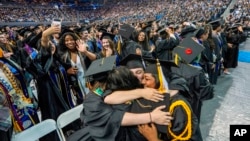
The 12-month grace period for student loan borrowers ended on September 30. The "on-ramp" period helped borrowers who are struggling to make payments avoid the risk of defaulting and hurting their credit score.
"The end of the on-ramp period means the beginning of the potentially harsh consequences for student loan borrowers who are not able to make payments," said Persis Yu, Deputy Executive Director at the Student Borrower Protection Center.
Around 43 million Americans have student loan debt, amounting to $1.5 trillion. Around eight million of those borrowers had enrolled in the SAVE plan, the newest income-driven repayment plan that extended the eligibility for borrowers to have affordable monthly student loan payments. However, this plan is currently on hold due to legal challenges.
With the on-ramp period and a separate program known as Fresh Start ending and the SAVE plan on hold, student loan borrowers who are struggling to afford their monthly payments have fewer options, added Yu. Student loan borrowers who haven't been able to afford their monthly payments must consider their options to avoid going into default.
If you have student loans, here's what you need to know.
What was the on-ramp period?
The Education Department implemented this grace period to ease the borrower's transition to make payments after a three-year payment pause during the COVID-19 pandemic. During this year-long period, borrowers were encouraged to keep making payments since interest continued to accumulate.
"Normally, loans will default if you fall about nine months behind on making payments, but during this on-ramp period, missed payments would not move people towards defaulting and then being subject to forced collections. However, if you missed payments, you still be falling behind ultimately on repaying your loans," said Abby Shaforth, director of National Consumer Law Center's Student Loan Borrower Assistance Project.
Since this grace period has ended, student loan borrowers who don't make payments will go delinquent or, if their loans are not paid for nine months, go into default.
Borrowers who cannot afford to make payments can apply for deferment or forbearance, which pause payments, though interest continues to accrue.
What happens if I don't make my payments?
Borrowers who can't or don't pay risk delinquency and eventually default. That can badly hurt your credit rating and make you ineligible for additional aid and government benefits.
If a borrower missed one month's payment, they will start receiving email notifications, said Shaforth. Once the loan hasn't been paid for three months, loan servicers notify to the credit reporting agencies that the loan is delinquent, affecting your credit history. Once the borrower hasn't paid the loan for nine months, the loan goes into default.
If you're struggling to pay, advisers first encourage you to check if you qualify for an income-driven repayment plan, which determines your payments by looking at your expenses. You can see whether you qualify by visiting the Federal Student Aid website. If you've worked for a government agency or a non-profit organization, you could also be eligible for the Public Service Loan Forgiveness Program, which forgives student debt after 10 years.
What happens when a loan goes into default?
When you fall behind on a loan by 270 days — roughly nine months — the loan appears on your credit report as being in default.
Once a loan is in default, it goes into collections. This means the government can garnish wages (without a court order) to go towards paying back the loan, intercept tax refunds, and seize portions of Social Security checks and other benefit payments.
What if I can't pay?
If your budget doesn't allow you to resume payments, it's important to know how to navigate the possibility of default and delinquency on a student loan. Both can hurt your credit rating, which would make you ineligible for additional aid.
If you're in a short-term financial bind, you may qualify for deferment or forbearance — allowing you to temporarily suspend payment.
To determine whether deferment or forbearance are good options for you, you can contact your loan servicer. One thing to note: interest still accrues during deferment or forbearance. Both can also impact potential loan forgiveness options. Depending on the conditions of your deferment or forbearance, it may make sense to continue paying the interest during the payment suspension.
What is an income-driven repayment plan?
The U.S. Education Department offers several plans for repaying federal student loans. Under the standard plan, borrowers are charged a fixed monthly amount that ensures all their debt will be repaid after 10 years. But if borrowers have difficulty paying that amount, they can enroll in one of several plans that offer lower monthly payments based on income and family size. Those are known as income-driven repayment plans.
Income-driven options have been offered for years and generally cap monthly payments at 10% of a borrower's discretionary income. If a borrower's earnings are low enough, their bill is reduced to $0. And after 20 or 25 years, any remaining debt gets erased.
What is the latest with the SAVE program?
In August, the Supreme Court kept on hold the SAVE plan, the income-driven repayment plan that would have lowered payments for millions of borrowers, while lawsuits make their way through lower courts.
Eight million borrowers who had already enrolled in the SAVE plan don't have to pay their monthly student loan bills until the court case is resolved. Debt that already had been forgiven under the plan was unaffected.
The next court hearing about this case will be held on October 15.
What happened with the Fresh Start program?
The Fresh Start program, which gave benefits to borrowers who were delinquent prior to the pandemic payment pause, also closed on September 30. During this limited program, student loan borrowers who were in default prior to the pandemic were given the opportunity to remove their loans from default, allowing them to enroll in income-driven payment plans, or apply for deferment, among other benefits.
Boston university relaunches journalism curriculum to encompass humanities

As the fall semester begins, a women’s college in Boston, Massachusetts, has retooled its media-related curriculum to best reflect the ideals of the school’s namesake, the late journalist Gwen Ifill.
Simmons University announced it would relaunch the media school as the Gwen Ifill School of Media, Humanities and Social Sciences. A search committee also named media scholar Ammina Kothari as the new dean.
The Ifill School’s new structure expands its media curriculum to include humanities and social sciences. The attributes that defined Ifill also shape a new, holistic approach, “An unwavering commitment to accuracy and objectivity, a nuanced understanding of social and historical context and a compassion-based appreciation of policymaking’s real-world implications,” according to a Simmons press release.
“Folks here are very proud of Gwen’s legacy and want to honor it in many different ways,” said Bert Ifill, Gwen’s brother and a longtime university administrator.
A crucial component of the Ifill School is its emphasis on communications, a field Gwen excelled in, Bert told VOA.
After graduating from Simmons in 1977, she had long careers in both print and television journalism, working for The Baltimore Evening Sun, The Washington Post, The New York Times, NBC and PBS. She covered seven presidential campaigns and died in 2016 at age 61.
Ifill was the first African American woman to moderate a vice presidential debate and to coanchor a national newscast, “PBS NewsHour.”
“Gwen valued storytelling, and she was an amazing journalist,” Kothari, the school’s new dean, told VOA. “But she also worked really hard to raise awareness about important social issues and to highlight underrepresented voices.”
Abigail Meyers, a current junior at the Ifill School, admires the journalist’s “groundbreaking work” in both journalism and racial justice, she told VOA. Raised near Baltimore, Maryland, Meyers feels a special connection to Ifill’s work for the Baltimore Evening Sun newspaper.
The school has been instrumental in supporting Meyers’ aspirations to become a professional journalist, she told VOA.
“The support that you get from the faculty and alumni is unlike really any other journalism program,” she said.
Being a double major in communications and political science, Meyers appreciates the new curriculum’s flexibility, as she is able to take classes across different disciplines.
This flexibility will help prime Simmons’ students to achieve success, Kothari said. She believes interdisciplinary training leads to stronger leaders in the world.
“As we think about communications or media, including journalism or social sciences, we need a strong foundation in humanities to understand the historical context for what we see happening today,” Kothari said.
The school’s increased focus on humanities “couldn’t be more timely,” according to the press release. Nearly three of four Americans believe media literacy is an important skill in today’s news landscape, a 2023 Boston University survey found.
However, humanities-focused degree programs like the Ifill School’s receive little recognition. Of all the bachelor’s degrees awarded in 2020, humanities degrees made up less than 10%, a number that has only been decreasing, according to a 2022 MIT study. Meanwhile, science, technology, engineering and math degrees, or STEM, have grown exponentially.
But humanities and STEM shouldn’t be seen as opposites, Kothari said.
She cited the COVID-19 pandemic response as an example. Many precautionary measures such as social distancing were grounded in “amazing scientific research,” but weren’t effectively communicated to the public, she said.
“As we have new knowledge being produced, we also need journalists,” Kothari said. “We need communicators who are able to translate very complex information to the audience so they can see, ‘How does it matter to me? What is the effect for me?’”
Ifill’s legacy is not only celebrated within her namesake school, but also through press freedom organizations around the world.
The Committee to Protect Journalists, a press freedom nonprofit, honors Ifill with the annual Gwen Ifill Press Freedom Award, which is presented to individuals who have “shown extraordinary and sustained achievement in the cause of press freedom,” according to CPJ’s website.
Christophe Deloire, the late director of international media freedom organization Reporters Without Borders, or RSF, received the 2024 Gwen Ifill Press Freedom Award.
“Christophe was one of journalism's greatest-ever champions,” RSF Executive Director Clayton Weimers told VOA in an email. “There was hardly a fight or an advance in press freedom in the past decade that he wasn't a part of, if not leading.”
As Ifill’s legacy spreads, there is one person who couldn’t be prouder: her brother, Bert. He told VOA it often seems as though his full-time job is “to talk nicely about Gwen.”
“It's always a great pleasure and honor for me to talk about her and to talk about her legacy, not only as obviously a very skilled journalist, but as an extraordinary mentor and confidant,” he said.
China’s youth unemployment fuels rise in postgraduate studies

Youth unemployment in China climbed to nearly 19% in August, its highest level so far this year, according to official data. Analysts say that the higher level of youth unemployment is driving more college graduates to enroll in graduate schools to escape the job search as the world’s second-largest economy struggles.
According to data released by the National Bureau of Statistics, or NBS, late last week, the unemployment rate among 16- to 24-year-olds rose from 17.1% in July to 18.8% in August. One big reason for the uptick in joblessness, the NBS said, is that nearly 12 million students graduated from Chinese universities this June, heightening competition in an already tough job market.
Postgraduates overtake graduates
“The job market has shrunk, and at the same time there are still so many graduates. Too many people are idling every day,” said Lin Chan-Hui, an assistant professor of the General Education Center at Feng Chia University in Taiwan. “Another way out is to return to school to study further and temporarily escape the competitive workplace.”
Some Chinese universities say they are seeing more postgraduate students than undergraduates.
According to the state-backed digital publication The Paper, the number of graduate students at Lanzhou University exceeded the total number of undergraduate students for the first time. Lanzhou University is located in the capital of northwestern China’s Gansu Province.
In eastern China’s coastal Zhejiang Province, the Zhejiang University of Technology shows 5,382 new graduate students were admitted this year, beating out the number of new undergraduate students by 40.
The trend was already picking up at more famous Chinese universities last year.
Last December, Beijing’s Tsinghua University said the number of undergraduate freshmen in the previous academic year was 3,760, while the number of master's and doctoral students was 12,069.
Shanghai’s Fudan University in October 2023 reported 15,000 undergraduate students and nearly 37,000 graduate students.
China's Ministry of Education said that last year there were more than 47 million people enrolled in higher education institutes, 1.3 million were graduate students, according to the official Xinhua News Agency.
Lei, a higher education consultant in Shenzhen, who due to the sensitivity of the subject only gave his surname, told VOA the trend of higher education is moving toward "college graduates who don’t go to graduate school would immediately become unemployed" amid China's economic slowdown.
"On one hand, studying in graduate school can really help you find a job. On the other hand, it’s also an avoidance mentality,” Lei said.
Wandering masters and doctors
Feng Chia University’s Lin said that having an undergraduate degree is not enough in fields like technological innovation and scientific research, so it is still necessary to get a postgraduate degree in certain fields.
On the other hand, he said, China has too many people getting doctorates and master’s degrees and not enough technical and vocational education so there will be "fierce competition for upper-level work, but no one does the lower-level work." Highly educated young people are not willing to engage in grassroots work, Lin said, so there will be more and more "wandering masters and doctors."
Lin said the geopolitical tension between China and the U.S. has also made studying abroad for a postgraduate degree harder, so more students choose a domestic one instead.
Chinese netizens seem to agree that waiting for the job market to improve is their best hope.
A Hunan netizen on China’s Weibo social media platform under the name "Da Ke Ya Tang" said: "The market will not be able to provide so many jobs in the foreseeable future, so we have to leave the problem to the future."
"If colleges and universities cannot adapt to the country's demand for innovative and pioneering talents and reform the way students are trained, more employment pressure may accumulate in society in a few years," writer Wang Guojin said in a post on Weibo.
COVID students coping?
A PhD student in Shanghai who, due to the sensitivity of the subject, only gave his surname Zeng, told VOA the increase in master's and doctoral students is also because many graduate students went to college during the COVID-19 pandemic and are struggling to adapt. Zeng blames remote learning for their struggles with social interaction and the skills needed to compete in the job market.
"This group of college students obviously lacks some socialization skills, at least in recruitment interviews,” Zeng said. “They can't reach the same level as the previous students.”
Zeng adds that monthly stipends for master's and doctoral students ranges from roughly $143 to $700 and Chinese universities encourage entrepreneurship by providing funds to start small projects through competitions.
“Who wouldn’t want to continue their studies and earn money at the same time?” she asked.
Adrianna Zhang contributed to this report.
Many US college students eligible for federal food money

Many college students in the United States are eligible for the Supplemental Nutrition Assistance Program, or SNAP, previously known as food stamps, administered by the U.S. Department of Agriculture.
But often, students don’t take advantage of the program because of complicated rules or a lack of awareness. U.S. News and World Report explains who can enroll and how to get benefits. (September 2024)
Islamic group files lawsuit against University of Georgia
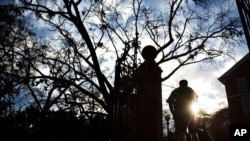
The chapter of the Council on American-Islamic Relations in the U.S. state of Georgia filed a lawsuit against the University of Georgia alleging anti-Muslim discrimination.
The lawsuit says students associated with a group advocating for Palestinian justice have been the target of harassment on campus, and the university took no meaningful action to end the harassment, Atlanta News First reported. (September 2024)
Board approves more non-lethal weapons for UCLA police after Israel-Hamas war protests

The University of California board of regents approved Thursday additional non-lethal weapons requested by UCLA police, which handled some of the nation's largest student protests against the Israel-Hamas war.
Clashes between protestors and counter-protestors earlier this year on the campus led to more than a dozen injuries, and more than 200 people were arrested at a demonstration the next day.
The equipment UCLA police requested and the board approved included pepper balls and sponge rounds, projectile launchers and new drones. The board also signed off on equipment purchase requests for the nine other police departments on UC campuses.
Student protesters at the regents meeting were cleared from the room after yelling broke out when the agenda item was presented.
Faculty and students have criticized UCLA police for their use of non-lethal weapons in campus demonstrations, during which some protesters suffered injuries.
During public comment, UCLA student association representative Tommy Contreras said the equipment was used against peaceful protestors and demonstrators.
"I am outraged that the University of California is prioritizing funding for military equipment while slashing resources for education," Contreras said. "Students, staff and faculty have been hurt by this very equipment used not for safety but to suppress voices."
California law enforcement agencies are required by state law to submit an annual report on the acquisition and use of weapons characterized as "military equipment." A UC spokesperson called it a "routine" agenda item not related to any particular incidents.
"The University's use of this equipment provides UC police officers with non-lethal alternatives to standard-issue firearms, enabling them to de-escalate situations and respond without the use of deadly force," spokesperson Stett Holbrook said.
Many of the requests are replacements for training equipment, and the drones are for assisting with search and rescue missions, according to Holbrook. The equipment is "not military surplus, nor is it military-grade or designed for military use," Holbrook said.
UCLA police are requesting 3,000 more pepper balls to add to their inventory of 1,600; 400 more sponge and foam rounds to their inventory of 200; eight more "less lethal" projectile launchers; and three new drones.
The report to the regents said there were no complaints or violations of policy found related to the use of the military equipment in 2023.
History professor Robin D.G. Kelley said he spent an evening with a student in the emergency room after the student was shot in the chest during a June 11 demonstration.
"The trauma center was so concerned about the condition of his heart that they kept him overnight to the next afternoon after running two echocardiograms," Kelley said the day after the student was injured. "The student was very traumatized."
UC's systemwide director of community safety Jody Stiger told the board the weapons were not to be used for crowd control or peaceful protests but "life-threatening circumstances" or violent protests where "campus leadership have deemed the need for law enforcement to utilize force to defend themselves or others."
Historically Black colleges see surge in applications
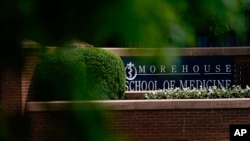
After the Supreme Court’s ruling banning affirmative action in college applications, competitive schools are reporting a decline in first-time minority enrollment.
But the nation’s historically Black colleges and universities are seeing a surge in applications, Liam Knox writes in Inside Higher Ed. (September 2024)
- By VOA News
Fewer men enrolling in college
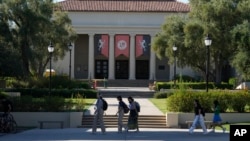
In the last few years, the number of men enrolled in U.S. colleges and universities has dropped by 6%, and the proportion of male students is at an all-time low of 41%.
Lauren Hamilton of WAMU American University Radio looks at why the shift is happening, and what universities are doing about it. (August 2024)
Nine charged in police breakup of pro-Palestinian camp at US university

Authorities have filed charges against nine people who are accused of trespassing or resisting police during the May breakup of a pro-Palestinian camp at the University of Michigan.
"The First Amendment does not provide a cover for illegal activity," Attorney General Dana Nessel said Thursday, a day after charges were filed in Washtenaw County.
The camp on the Diag, known for decades as a site for campus protests, was cleared by police on May 21 after a month. Video posted online showed police using what appeared to be an irritant to spray people, who were forced to retreat.
The university said the camp had become a threat to safety, with overloaded power sources and open flames.
Nessel said two people were charged with trespassing, a misdemeanor, and seven more people were charged with trespassing as well as resisting police, a felony.
Protesters have demanded that the school's endowment stop investing in companies with ties to Israel. But the university insists it has no direct investments and less than $15 million placed with funds that might include companies in Israel. That's less than 0.1% of the total endowment.
U.S. Representative Rashida Tlaib, a Detroit Democrat who supports the protesters, said the charges were "frivolous" and a "shameful attack" on the rights of students.
Separately, Nessel said state prosecutors charged two people for alleged acts during a counterdemonstration on April 25, a few days after the camp was created.
Nessel said authorities still were investigating spring protests at the homes of elected members of the university's governing board.
- By VOA News
Colleges get ready for return of protests

After a summer lull when most students left campuses, colleges and universities are getting ready for the possible return of protests over the war in Gaza.
USA Today reports that while activists are likely to resume demonstrations, many schools have prepared by enacting harsher rules for those causing disruptions. (August 2024)
US research university ends ties with school in China

Amid national security concerns, the Georgia Institute of Technology has ended its partnership with Tianjin University in Shenzhen, which U.S. lawmakers say has ties to the Chinese military.
The Washington Post reported that an official at Georgia Tech said the Georgia Tech Shenzen Institute became untenable because of a problematic partnership, global politics and pending legislation. (September 2024)







